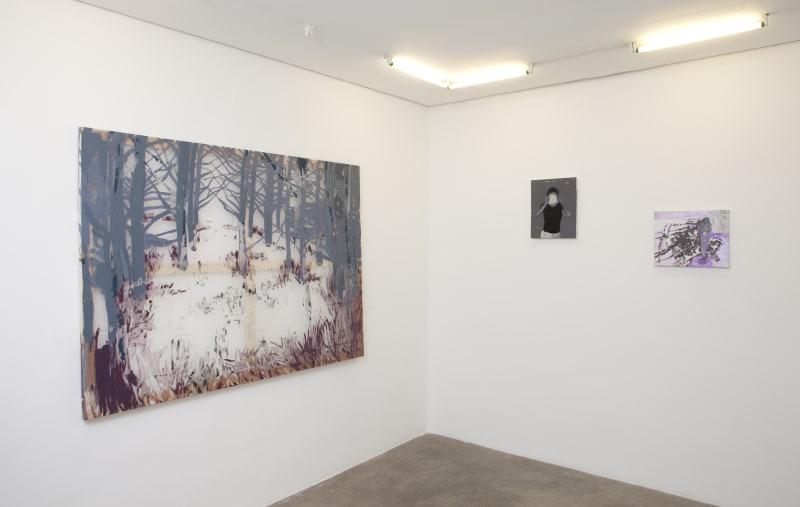Holzweg Marina Perez Simão
Past exhibition
Overview
Mendes Wood is proud to present Holzweg, the second solo show of Marina Simão at the gallery. For the exhibition, the space will be occupied by large and small paintings in iridescent, reflective pigments on superimposed, transparent textiles. The works’ supports range from oriental paper of apparent fragility – paper usually used for calligraphy in Korea and Japan – to firmer materials such as sheets of vinyl, polyester and plastic.
The show’s title is an adaptation of a term borrowed from the Existentialist philosopher Martin Heidegger. Holzweg, German for “wood paths,” is used by Heidegger to convey an idea of paths leading to nowhere, or the simple act of wandering for its own sake. Simão alludes to this image of the wanderer in the woods with a body of paintings depicting mature forests, the density of which obscures the linearity of the horizon, or conceptual destination. In tentative, uncorrected brushstrokes, she renders landscapes at once familiar and strange, the discontinuous and otherworldly skylines of which appear to be lit by lightning.
The works gathered in Holzweg recall the medieval monastic proverb, “There are no paths ... there is only the travelling.” They also follow a similar mentality expressed in Soren Kierkegaard’s work when he writes, “In a physical sense a road is an external actuality, no matter whether one is walking on it or not, no matter how the individual travels on it – the road is the road. But in the spiritual sense, the road comes into existence only when we walk on it. That is, the road is how it is walked.” (p. 55, “Provocations”)
It is of great importance to draw attention to the nature of Simão’s paintings, which are are paintings of paintings, many times over, results of a protracted, imperfect study of recollection of a theme or source image. As the voice of the original image recedes into echoes, the painting itself gains a silence, an emptiness of meaning presented as a blank receptacle to the experience of the viewer. Simão remarks, “As I paint and repaint borrowed images, I am not interested in appropriating their meaning, but rather, in gaining the freedom to pass unhindered through them. In this newfound emptiness the spectator cum participant is asked to walk and to give these amorphous works the structure of his own experience.”
Marina Simão (1980) has recently exhibited at the Musée d’Art Moderne de Saint Etienne, France, the Galleria delle Colonne, Parma, Italy, Palazzo Dei Falconieri, Roma, Italy, and the Daejeon Museum of Art, Daejeon, South Korea, the Biennial of Ponzan, Poznan, Poland, the Museum of Yugoslavian History, Belgrade, Serbia, and the Crystal Palace Gallery, Museum of the city of Porto, Porto, Portugal.
The show’s title is an adaptation of a term borrowed from the Existentialist philosopher Martin Heidegger. Holzweg, German for “wood paths,” is used by Heidegger to convey an idea of paths leading to nowhere, or the simple act of wandering for its own sake. Simão alludes to this image of the wanderer in the woods with a body of paintings depicting mature forests, the density of which obscures the linearity of the horizon, or conceptual destination. In tentative, uncorrected brushstrokes, she renders landscapes at once familiar and strange, the discontinuous and otherworldly skylines of which appear to be lit by lightning.
The works gathered in Holzweg recall the medieval monastic proverb, “There are no paths ... there is only the travelling.” They also follow a similar mentality expressed in Soren Kierkegaard’s work when he writes, “In a physical sense a road is an external actuality, no matter whether one is walking on it or not, no matter how the individual travels on it – the road is the road. But in the spiritual sense, the road comes into existence only when we walk on it. That is, the road is how it is walked.” (p. 55, “Provocations”)
It is of great importance to draw attention to the nature of Simão’s paintings, which are are paintings of paintings, many times over, results of a protracted, imperfect study of recollection of a theme or source image. As the voice of the original image recedes into echoes, the painting itself gains a silence, an emptiness of meaning presented as a blank receptacle to the experience of the viewer. Simão remarks, “As I paint and repaint borrowed images, I am not interested in appropriating their meaning, but rather, in gaining the freedom to pass unhindered through them. In this newfound emptiness the spectator cum participant is asked to walk and to give these amorphous works the structure of his own experience.”
Marina Simão (1980) has recently exhibited at the Musée d’Art Moderne de Saint Etienne, France, the Galleria delle Colonne, Parma, Italy, Palazzo Dei Falconieri, Roma, Italy, and the Daejeon Museum of Art, Daejeon, South Korea, the Biennial of Ponzan, Poznan, Poland, the Museum of Yugoslavian History, Belgrade, Serbia, and the Crystal Palace Gallery, Museum of the city of Porto, Porto, Portugal.
Works
-
 Marina Perez Simão, Sem Título, 2012
Marina Perez Simão, Sem Título, 2012 -
 Marina Perez Simão, Sem Título, 2012
Marina Perez Simão, Sem Título, 2012 -
 Marina Perez Simão, Sem Título, 2012
Marina Perez Simão, Sem Título, 2012 -
 Marina Perez Simão, Sem Título, 2012
Marina Perez Simão, Sem Título, 2012 -
 Marina Perez Simão, Sem Título, 2012
Marina Perez Simão, Sem Título, 2012 -
 Marina Perez Simão, Sem Título, 2013
Marina Perez Simão, Sem Título, 2013 -
 Marina Perez Simão, Sem Título, 2012
Marina Perez Simão, Sem Título, 2012 -
 Marina Perez Simão, Sem título, 2013
Marina Perez Simão, Sem título, 2013 -
 Marina Perez Simão, Sem Título, 2012
Marina Perez Simão, Sem Título, 2012
Installation Views











